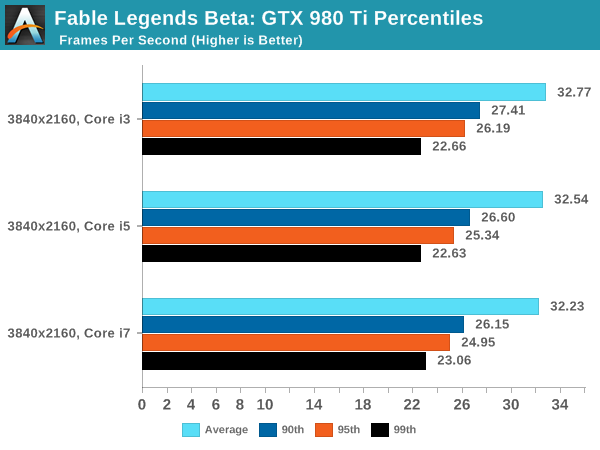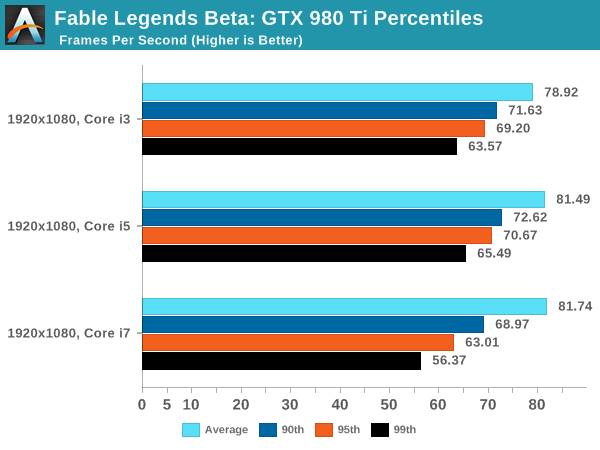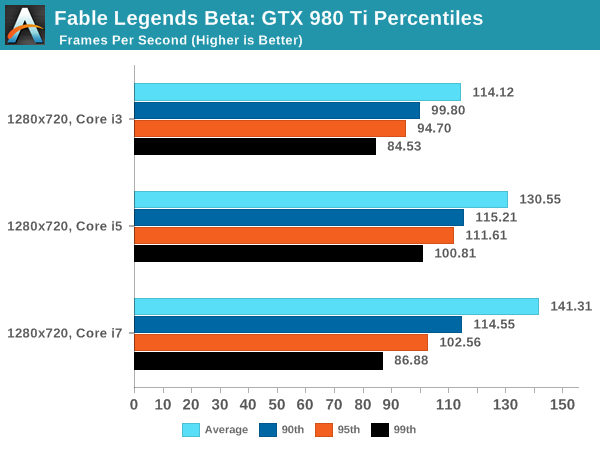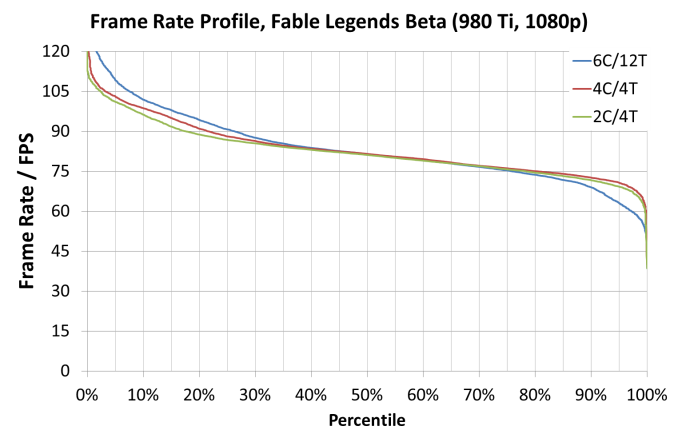Fable Legends Early Preview: DirectX 12 Benchmark Analysis
by Ryan Smith, Ian Cutress & Daniel Williams on September 24, 2015 9:00 AM ESTDiscussing Percentiles and Minimum Frame Rates
Up until this point we have only discussed average frame rates, which is an easy number to generate from a benchmark run. Discussing minimum frame rates is a little tricky, because it could be argued that the time taken to render the worst frame should be the minimum. All it then takes is a bad GPU request (misaligned texture cache) which happens infrequently to provide skewed data. To this end, thanks to the logging functionality of the benchmark, we are able to report the frame rate profiles of each run and percentile numbers.
For the GTX 980 and AMD Fury X, we pulled out the 90th, 95th and 99th percentile data from the outputs, as well as plotting full graphs. For each of these data points, the 90th percentile should represent the frame rate (we’ll stick to reporting frame rates to simplify the matter) a game will achieve during 90% of the frames. Similar logic applies to the 95th and 99th percentile data, where these are closer to the absolute maximum but should be more consistent between runs.
This page (and the next) is going to be data heavy, but our analysis will discuss the effect of CPU scaling on percentile data on both GPUs in all three resolutions using all three CPUs. Starting with the GTX 980 Ti:

All three arrangements at 3840x2160 perform similarly, though there are slight regressions moving from the i3 to the i7 along most of the range, perhaps suggesting that having an excess of thread data has some issues. The Core i7 arrangement seems to have the upper hand at the low percentile (2%-4%) numbers as well.

At 1080p, the Core i7 gives greater results when the frame rate is above the average and we see some scaling effects when the scenes are simple (giving high frame rates). But for whatever reason, when the going gets tough the i7 seems to bottom out as we go beyond the 80th percentile.

If we ever wanted to see a good representation of CPU scaling, the 720p graph is practically there – all except for the 85th percentile and up which makes the data points pulled out in this region perhaps unrepresentative of the whole. This issue might be the same issue when it comes to the 1080p results as well.













141 Comments
View All Comments
tackle70 - Thursday, September 24, 2015 - link
Nice article. Maybe tech forums can now stop with the "AMD will be vastly superior to Nvidia in DX12" nonsense.cmdrdredd - Thursday, September 24, 2015 - link
Leads me to believe more and more that Stardock is up to shenanigans just a bit or that not every game will use certain features that DX12 can perform and Nvidia is not held back in those games.Jtaylor1986 - Thursday, September 24, 2015 - link
I'd say Ashes is a far more representative benchmark. What is the point of doing a landscape simulator benchmark. This demo isn't even trying to replicate real world performancecmdrdredd - Thursday, September 24, 2015 - link
Are you nuts or what? This is a benchmark of the game engine used for Fable Legends. It's as good a benchmark as any when trying to determine performance in a specific game engine.Jtaylor1986 - Thursday, September 24, 2015 - link
Except its completely unrepresentative of actual gameplay unless this grass growing simulator.Jtaylor1986 - Thursday, September 24, 2015 - link
"The benchmark provided is more of a graphics showpiece than a representation of the gameplay, in order to show off the capabilities of the engine and the DX12 implementation. Unfortunately we didn't get to see any gameplay in this benchmark as a result, which would seem to focus more on combat."LukaP - Thursday, September 24, 2015 - link
You dont need gameplay in a benchmark. you need the benchmark to display common geometry, lighting, effects and physics of an engine/backend that drives certain games. And this benchmark does that. If you want to see gameplay, there are many terrific youtubers who focus on that, namely Markiplier, NerdCubed, TotalBiscuit and othersMr Perfect - Thursday, September 24, 2015 - link
Actual gameplay is still important in benchmarking, mainly because that's when framerates usually tank. An empty level can get fantastic FPS, but drop a dozen players having an intense fight into that level and performance goes to hell pretty fast. That's the situation where we hope to see DX12 outshine DX11.Stuka87 - Thursday, September 24, 2015 - link
Wrong, a benchmark without gameplay is worthless. Look at Battlefield 4 as an example. Its built in benchmarks are worthless. Once you join a 64 player server, everything changes.This benchmark shows how a raw engine runs, but is not indicative of how the game will run at all.
Plus its super early in development with drivers that stil need work, which the article states that AMD's driver arrived too late.
inighthawki - Thursday, September 24, 2015 - link
Yes, but when the goal is to show improvements in rendering performance, throwing someone into a 64 player match completely skews the results. The CPU overhead of handling a 64 player multiplayer match will far outweigh to small changes in CPU overhead from a new rendering API.